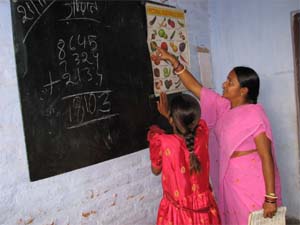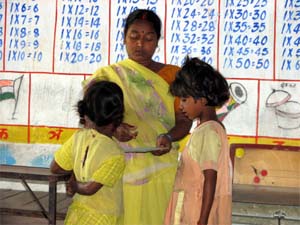Dec 18, 2025
Dec 18, 2025
In a few weeks from now, 124,000 new women employees across Bihar will receive their first salary cheque. Meet the new force of women teachers in the state, appointed last year in a large-scale recruitment drive, when the state government approved new recruitment rules for the appointment of over 200,000 teachers for primary, middle, secondary and senior-secondary schools. This move was in order to clear a huge backlog of vacancies pending for over a decade.
In the first phase, the process for the recruitment of 124,000 primary and middle school teachers and 12,000 secondary school teachers, was initiated in August last year. The government had decided to appoint 236,000 regular teachers (including 211,000 elementary school teachers); do away with the Para Teacher System (PSM); create 60,000 new teacher posts to take care of the 2.3 million out-of-school children and, interestingly, reserve 50 per cent of the posts for
women.
A decision was made to appoint regular teachers in panchayat/prakhand/nagar palika (village, block and civic) elementary schools with a salary of Rs 4,000 for untrained teachers and Rs 5,000 for trained teachers. The state government also approved all serving Para teachers as panchayat/nagar shikshaks in July 2006. The government also issued separate rules for appointment of teachers in rural and urban areas.
Devolving the powers of appointment of teachers to local bodies, the government envisaged a decentralized and transparent recruitment processes, with emphasis on merit. In all, 38 recruitment units at the district level; 534 at block level; and 8,545 at the panchayat (village council) level were constituted for rural areas, besides 272 recruitment units for urban areas.
The recruitment of teachers in such large numbers created a record of sorts at every stage of the process. Over 8.7 million persons applied for various posts. So much so that post offices in Bihar ran out of postage stamps. This drive came as a ray of hope for all the unemployed, educated people. And for women, it meant empowerment and a newfound self-worth.
Meet Neera Kumari (35). Till November last year, Neera was an ordinary housewife, who spent her day immersed in household chores and attending to her two school-going children. Appointed a government schoolteacher at the Hindi Madhya Vidyalaya in Gangapatti village, three kilometres away from her home, Neera is now able to supplement her husband's income. Excited about her new job and the imminent salary, she plans to save around half of her Rs 4,000-monthly emolument. For Neera, who has a class 12 certificate, the job is a dream come true.
 Savita Kumari (34), a teacher in Jedhuli panchayat, is disabled. But this does not deter her from travelling from Patna to Fatuha by train every day to teach at the primary school in Kachchi Dargah. A mother of three girls, she now rises even earlier to complete her household chores and then reach Fatuha by 6 am, which is when her school starts. Early morning blues do not trouble Savita. Her new job has given her a sense of achievement and empowerment. "Sitting at home, I used to feel cut-off from the world. I felt dependent on my husband for every small thing. Now I feel that even I am capable and can bring a change in my life and also in the lives of my daughters." She has resolved to spend whatever she saves from her salary of Rs 5,000 on the education of her daughters.
Savita Kumari (34), a teacher in Jedhuli panchayat, is disabled. But this does not deter her from travelling from Patna to Fatuha by train every day to teach at the primary school in Kachchi Dargah. A mother of three girls, she now rises even earlier to complete her household chores and then reach Fatuha by 6 am, which is when her school starts. Early morning blues do not trouble Savita. Her new job has given her a sense of achievement and empowerment. "Sitting at home, I used to feel cut-off from the world. I felt dependent on my husband for every small thing. Now I feel that even I am capable and can bring a change in my life and also in the lives of my daughters." She has resolved to spend whatever she saves from her salary of Rs 5,000 on the education of her daughters.
Nanda Devi (49), another panchayat teacher of the primary school in Naraina, in Fatuha, was earlier an 'anganwadi' (village childcare centre) worker. Combining her former experience and current position, she motivates villagers to enroll their children into the school. The large-scale recruitment of women teachers will lead to the education of entire families, opines Nanda, who adds, "It will also lead to the development of villages."
 Archana Kumari (36) teaches all subjects at the primary school in Murajpur. It takes two hours from her home in the state capital to reach school - after an auto ride, a train journey and a long walk. Archana wakes up at an unearthly three a.m. to cook breakfast and complete her household chores for the day.
Archana Kumari (36) teaches all subjects at the primary school in Murajpur. It takes two hours from her home in the state capital to reach school - after an auto ride, a train journey and a long walk. Archana wakes up at an unearthly three a.m. to cook breakfast and complete her household chores for the day.
Yet, she beams with pride when she says, "This job has changed my life. There is a new vigor and enthusiasm in me. Previously, I had nothing important to do. I would sit idle after I finished my household work. Now I can earn my own living... I never thought I could get a job at my age."
In addition to their early morning-packed lunches, the new recruits, of which 60 per cent are women, carry with them a great level of enthusiasm and improved student-teacher interaction, into the government schools, earlier plagued by a high Pupil Teacher Ratio (PTR) of 65 students per teacher. The national average, according to National University of Educational Planning and Administration (NUEPA), 2007, is 36:1.
Incidentally, the recruitment also offers hope to the 240,000 children - between six to 14 years of age - who do not go to school. In fact, they should soon be seated in the 100,000 new classrooms currently under construction; and the 15,000 new schools underway, as per the state government's plans.
30-Jun-2007
More by : Manisha Parekh

|
I believe teaching ,timing. |